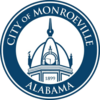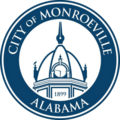Monroeville, Alabama facts for kids
Quick facts for kids
Monroeville
|
|||
|---|---|---|---|
|
City
|
|||
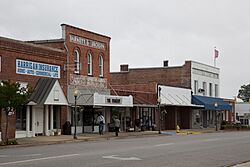
Historic buildings in Downtown Monroeville
|
|||
|
|||
| Nickname(s):
The Literary Capital of Alabama
|
|||
| Motto(s):
"Moving the Past Forward"
|
|||
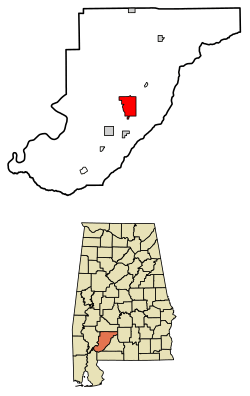
Location of Monroeville in Monroe County, Alabama.
|
|||
| Country | United States | ||
| State | Alabama | ||
| County | Monroe | ||
| Area | |||
| • Total | 13.36 sq mi (34.61 km2) | ||
| • Land | 13.35 sq mi (34.59 km2) | ||
| • Water | 0.01 sq mi (0.02 km2) | ||
| Elevation | 413 ft (126 m) | ||
| Population
(2020)
|
|||
| • Total | 5,951 | ||
| • Density | 445.63/sq mi (172.06/km2) | ||
| Time zone | UTC-6 (Central (CST)) | ||
| • Summer (DST) | UTC-5 (CDT) | ||
| ZIP codes |
36460–36462
|
||
| Area codes | 251 | ||
| FIPS code | 01-50192 | ||
| GNIS feature ID | 0152359 | ||
Monroeville is a city in Alabama, United States. It is the main town, or county seat, of Monroe County, Alabama. In 2020, about 5,951 people lived there.
Monroeville is famous for being the hometown of two well-known writers: Truman Capote and Harper Lee. They were friends when they were kids in the 1930s. Harper Lee's book, To Kill a Mockingbird, won a special award called the Pulitzer Prize. This book made Monroeville a popular place for tourists to visit. In 1997, the state of Alabama officially called Monroeville the "Literary Capital of Alabama."
The city is also connected to Walter McMillian. His story of being wrongly accused and later freed was told in the book Just Mercy by Bryan Stevenson. This book was also made into a movie. Another famous person from Monroeville is Cynthia Tucker, a journalist who won a Pulitzer Prize in 2007 for her writing.
Contents
History of Monroeville
For thousands of years, different groups of indigenous peoples lived in the area where Monroeville is now. In the 1830s, this land was given to the U.S. government.
The town was first called Walker's Mill and Store. It was named after Major Walker, who was one of the first European-American settlers there. In 1832, the main town of Monroe County was moved to Monroeville from Claiborne. For a short time, the settlement was called "Centerville" because it was in the middle of the county. Later, its name was officially changed to Monroeville. The town became a formal city on April 15, 1899.
Geography of Monroeville
Monroeville is located at 31°31′5″N 87°19′39″W / 31.51806°N 87.32750°W.
The United States Census Bureau says the city covers about 34.7 square kilometers (13.4 square miles). Most of this area, about 34.6 square kilometers (13.35 square miles), is land. A very small part, about 0.02 square kilometers (0.01 square miles), is water.
Population of Monroeville
| Historical population | |||
|---|---|---|---|
| Census | Pop. | %± | |
| 1880 | 122 | — | |
| 1900 | 422 | — | |
| 1910 | 616 | 46.0% | |
| 1920 | 1,017 | 65.1% | |
| 1930 | 1,355 | 33.2% | |
| 1940 | 1,724 | 27.2% | |
| 1950 | 2,772 | 60.8% | |
| 1960 | 3,632 | 31.0% | |
| 1970 | 4,846 | 33.4% | |
| 1980 | 5,674 | 17.1% | |
| 1990 | 6,993 | 23.2% | |
| 2000 | 6,862 | −1.9% | |
| 2010 | 6,519 | −5.0% | |
| 2020 | 5,951 | −8.7% | |
| U.S. Decennial Census 2013 Estimate |
|||
The population of Monroeville has changed over the years. In 2020, there were 5,951 people living in the city. There were 2,106 households and 1,259 families.
Racial Makeup of Monroeville
| Race | Num. | Perc. |
|---|---|---|
| White | 2,146 | 36.06% |
| Black or African American | 3,530 | 59.32% |
| Native American | 25 | 0.42% |
| Asian | 46 | 0.77% |
| Other/Mixed | 142 | 2.39% |
| Hispanic or Latino | 62 | 1.04% |
According to the 2020 census, most people in Monroeville are either White or Black/African American. There are also smaller groups of Native American, Asian, and other races. About 1% of the population is Hispanic or Latino.
Education in Monroeville
Monroeville is home to a branch campus of Coastal Alabama Community College. This college offers two-year programs and helps students learn new skills. Its main offices are in Bay Minette, Alabama.
The schools in Monroeville are part of the Monroe County School District.
Arts and Culture in Monroeville
Monroeville's Literary Fame
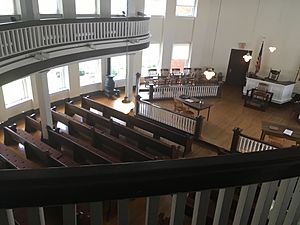
Author Harper Lee grew up in Monroeville. Her famous 1960 novel, To Kill a Mockingbird, is set in a made-up town called Maycomb. This town was inspired by her own hometown. Her other novel, Go Set a Watchman, also takes place in Maycomb.
Truman Capote, another famous writer, spent some of his childhood in Monroeville. He is known for books like Breakfast at Tiffany's and In Cold Blood. Harper Lee and Truman Capote were neighbors and stayed good friends their whole lives. Capote's early books, such as Other Voices, Other Rooms, were inspired by his time in Monroeville. Capote said that the character Dill in To Kill a Mockingbird was based on him. In return, Harper Lee was the inspiration for the character Idabel in Capote's Other Voices, Other Rooms.
Other writers from Monroeville include novelist Mark Childress and Cynthia Tucker. Cynthia Tucker is a newspaper writer who won the 2007 Pulitzer Prize for Commentary.
Annual Cultural Events
Many tourists visit Monroeville each year because of its connection to To Kill a Mockingbird. Every May, the Monroe County Heritage Museum puts on a play based on the book. Local volunteers act in the play, which is performed at the courthouse. The inside of this courthouse was even used as a guide for the movie version of To Kill a Mockingbird. The play has been performed in other cities, including Washington, D.C. In 1997, the Alabama Legislature officially named Monroeville the "Literary Capital of Alabama."
Monroeville in Television
In the TV show Private Practice, a character named Charlotte King was born in Monroeville. This show was created by Shonda Rhimes.
Notable People from Monroeville
Monroeville has been home to many interesting people:
- Marsha Barbour, who was the first lady of Mississippi.
- Truman Capote, a famous author.
- Mark Childress, a novelist.
- Marva Collins, an educator.
- Harper Lee, the author of To Kill a Mockingbird.
- Walter McMillian, who was freed after being wrongly accused.
- Allison Moorer, a folk singer.
- Fannie E. Motley, the first African-American student to graduate from Spring Hill College.
- Marie Rudisill, an author and TV personality.
- Bill Selby, a former baseball player.
- Cynthia Tucker, a journalist who won a Pulitzer Prize.
- Tytus Howard, a current football player for the Houston Texans.
Images for kids
See also
 In Spanish: Monroeville (Alabama) para niños
In Spanish: Monroeville (Alabama) para niños



